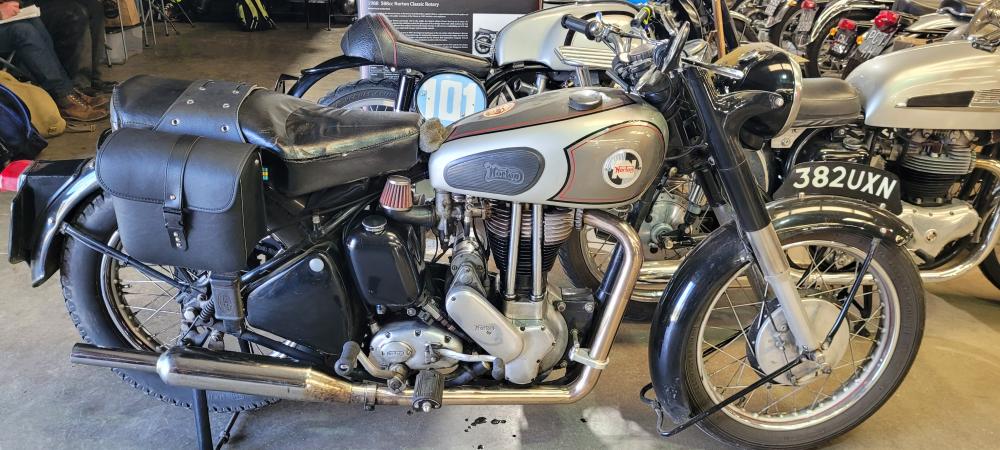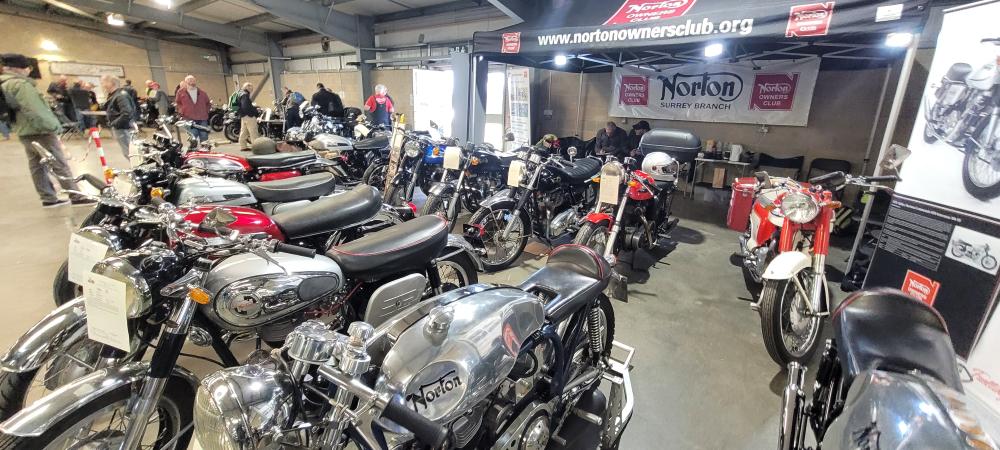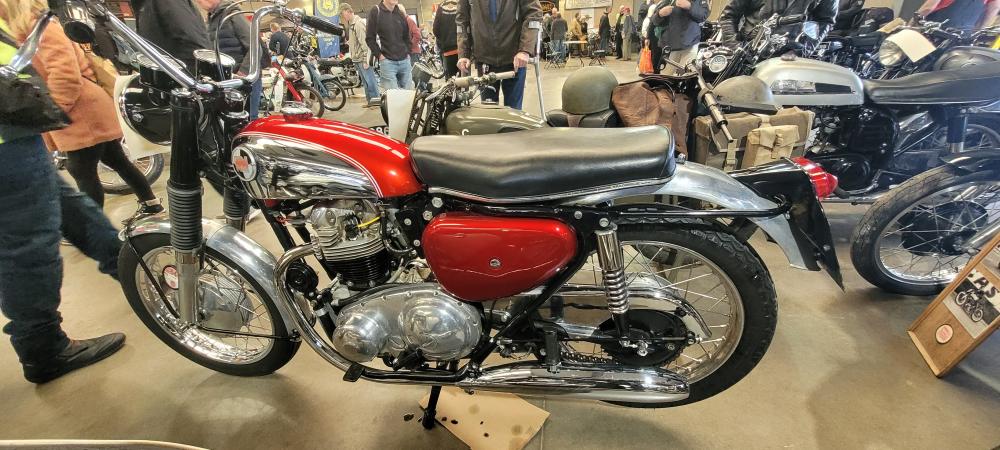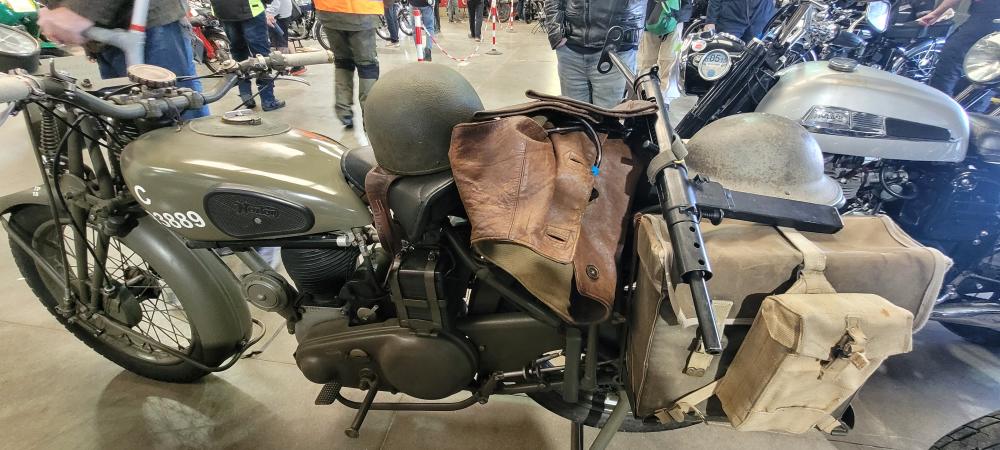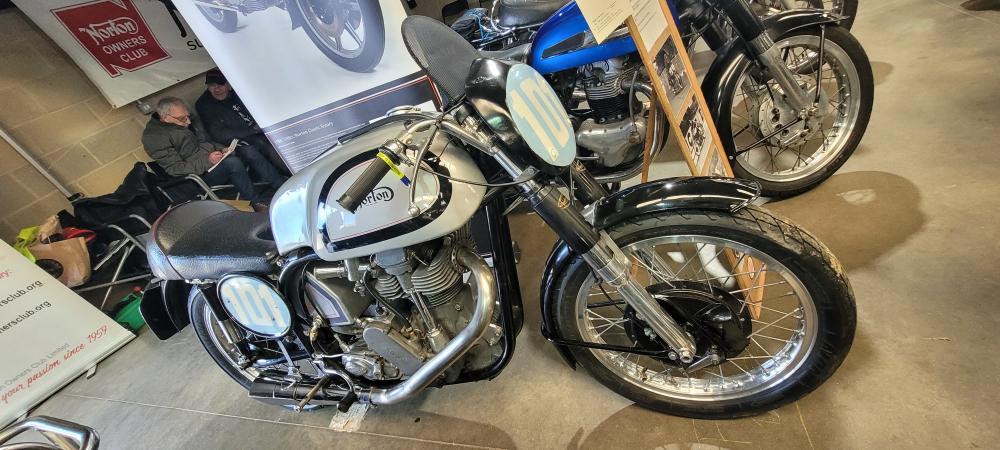NORTON TRIALS HISTORY 1945 to 54
Motor cycle sport quickly resumed after World War 11 and Norton resurrected its abandoned project for the 1940 season's trials models; a version of the ES2 with either 490 or 348cc ohv engine. Prototypes of this machine had been used by the Army's Norton mounted team in the 1939 ISDT By November, 1945 it was possible to build new machines for the factory's riders, five 490cc ohv machines with girder forks were built for Harold Daniell, new signing Geoff Gobder-Ford, Vic Brittain, a bike for Dublin Agent John Kelly and another machine for promising new corner John Hodgkinson. The pre-war 350s of Jack Williams and Ted Breffitt were also rebuilt, these 350 bikes retaining pre-war registration numbers.
Although not catalogued, production versions of these machines were made available early in 1946 to selected dealers and riders. These machines retained girder forks, though the work's machines were now fitted with teles and by September the new 1947 production versions were so equipped. The sidecar outfits of Dennis Mansell and Harold Flock continued in use, retaining girder forks on their outfits, as it had not yet been established that teles were suitable for trials chairs.
Matched against virtually standard AMC and BSA products, the new machines did not prove very competitive. With the exception of Geoff Gobder-Ford's solitary win in the Bemrose major success eluded the 'Works' team. Purchasers of the machines quickly found alternatives. In contrast Dennis Mansell took the sidecar premier in nearly all the 'Opens'. The continued success enjoyed by riders of ex WD bikes and pre-war open frame machines equipped with teles, (notably Ray Petty on Beart's special 350) together with recollection of pre-war success provoked thoughts for a radical rethink to meet the needs of the changing trials scene. Racing star Artie Bell had already interested the management in the engineering expertise of his partner Rex McCandless. Both Artie and Rex were accomplished trials riders and had been supplied, together with Ernie Lyons, with 500 and 350 Trials models for winter sport.
Acting as consultants to Norton, the Bell, McCandless partners evolved a new lighter bike, which used a substantial amount of WD16H items. This was to become the immortal 500T and Jack Blackwell, who had joined the Norton Trials Team for 1947 appeared at the Alan Trial in September on the prototype. A few weeks later at the Scott Trial, all the 'works' trials riders and Artie Bell were mounted on the new machines. The 350 and 500 Trials continued in production until the end of the 1947 season before the new model, the 500T was released for sale just before Christmas 1948. The solo short comings of the cradle frame did not apply when used with a sidecar. For several years these bikes were preferred to the 500T for use in the three wheel class, notably Arthur Humphries's 'works' outfit, with which he won the 1949 Experts and the 1950 Trials Drivers Star.
A few machines were built with ohc engines in this frame, two such being exported to North America (one a gift to Billy Matthew acknowledging his successes at Daytona) and two more were supplied to Harold Daniell for Johnny Lockett. (John had a square head Manx engine in his rigid trials model!) In February '48 the Trials Team of Jack Williams (having his final season), Ted Breffitt, Geoff Gobder-Ford and Jack Blackwell was augmented by Geoff Duke and Rex Young, followed in July by scrambler Ted Ogden. This substantial team achieved considerable success; they even won the Team Prize in the Scott Trial, one of the few team prizes the pre-war stars had never collected.
The machine revealed at the 1948 Show, closely resembled the Works prototypes. The most noticeable difference was the dull chrome plate on the petrol tank, an alloy version of the 1948 type 490cc engine, with alloy barrel and head, a 7ins. diameter front brake similar to the version used for road machines in '49. Norton claimed the machine weighed only 2981b. A figure probably taken without stand and toolbox, but much lighter than anything their rivals were able to offer at that time, even 350s. Only one 350T was ever assembled at the factory, Geoff Duke using a bike fitted with an engine from the earlier 350 Trials. It never went into production. A little known Works modification was to REDUCE the ground clearance on the factory bikes.
Undoubtedly the trials team enjoyed considerable success, Geoff Duke won the 1950 Victory Trial, but the dominance of pre-war years eluded them and the opposition did not have the added complication of winning international road races. Nevertheless in 1950 Rex Young narrowly missed a win in the Trials Driver's Star and was runner-up again in '52. Dick Clayton joined the team in 1951 and also added to the strength was private owner Jeff Smith. John Draper was recruited into the team for 1952, but problems with Avon tyres which refused to stay on the rim when run soft almost certainly cost him the 1952 Scottish Six Days Trial.
In the sidecar class Arthur Humphries won the 1949 Experts and tied for the 1951 Sidecar Trials Star, his outfit was effectively a 500 Trials, but his later successes were with featherbed Inters. Cyril Kemp took the Sidecar Class of the 1951 Experts with his privately owned 500T, demonstrating the true appeal of a machine, which ridden well could beat Factory runners. At the end of 1952 Associated Motor Cycles acquired a majority holding in the Norton Company and promptly closed down the Norton solo trials activities, this being in conflict with AJS and Matchless efforts. Arthur Humphries continued with a sidecar outfit and Factory Development Engineer Bob Collier, also contested the sidecar class with his home built specials, mostly twins. In 1958 and '59 Bob used a 600 Nomad Outfit, but Nomads were never sold in the UK. He then campaigned a Jubilee and later a Navigator outfit, his valiant efforts could be said to have been for publicity purposes.
The factory's trials riders and Ted Ogden contested the major scrambles with slightly modified 500Ts, though one, unloved by all, had a plunger back end. For the 1951 season, Ted Ogden was provided with a 500T motor in a featherbed frame, but he broke four frames before they solved the problem by fitting a more substantial head steady. For 1952 the factory produced four ohc scramblers in modified 500T swinging arm frames. Ridden by Draper, Rex Young and Les Archer, they performed quite well, but lacked development. AMC rubbished them and they were disposed of to Archer who won the European Championship. In 1956 Norton dodged the AMC scrutiny and Bob Collier produced two scramblers based on the road going ES2 frame, fitted with a 500T type engine. Bob's theory was that the Swedes were winning major scrambles with light machines using light simple ohv engines, the BSA and AMC engines were grossly over weight and had no bottom end punch. The 500T motor with Inter flywheels and a Manx piston was strong and gave the right power characteristics. AMC quickly rapped knuckles and scrapped the enterprise. These machines probably spawned the Nomad twin and the final chapter is provided by the Commando engined Wasp scramble outfits.
Post-war Norton continued its involvement with the International Six Days Trial. In 1948 continuing the pre-war approach, three 499cc Manx/Trials machines were built for Jack Williams, Jack Blackwell and Ted Breffit. Only Jack finished, but he gained another Gold and was in the winning Trophy Team. For 1949 four 500Ts with plunger rear springing were produced and Norton's team of Blackwell, Clayton and Young gained Gold Medals and a Manufacturers Team Award. For 1950 a slightly different approach was taken and four plunger sprung Dominators were modified for the event. Only Rex Young gained a Gold. For 1951 three twins with featherbed frames; fore runners of the Model 88 were built for Ted Breffitt, Dick Clayton and Rex Young; all won Gold Medals and another Team Award. A second team were entered on the previous year's bikes; Peter Baldwin, Jeff Smith and Eric Wilson all won Gold medals and a Manufacturers Team Award. Arguably the best British ISDT bike of the decade, the three featherbed machines were entered in the 1952 event, Ted Breffitt and Don Williams (taking over Jeff Smith's bike after he had a pre-trial accident) gained Golds; but for Stan Holmes, 1952 saw his only ever ISDT retirement, with a broken frame.
350 / 500 TRIALS
For the never implemented range for 1940 Norton had intended to offer a single trials model with either 348 or 490 ohv engines. It was to be based on the rigid ES2 frame and it is surmised that the three ES2 machines used by the Army in the 1939 ISDT were prototypes. The 'works' bikes built during 1945 followed this approach, had a short wheelbase rigid cradle frame, International type rear tank lug, Inter girder forks, WD adjustable handlebar clamps, WD rubber bump stops, some had the Manx 8" cone front brake and 21 x 3 and 18 x 4 inch Universal tyres. The petrol tank held just over 2 gallons and the engine was based on the standard Model 18 motor, but was fitted with an alloy Inter barrel and the alloy head developed for the 1938/39 bikes. Ignition was by either BTH or Lucas racing magnetos. A high level exhaust system with a 1937 type silencer was fitted. The gearbox had wide ratios and a folding kickstarter. The 350 used an 18 tooth engine sprocket, whilst the 500 had a 20 tooth sprocket. Racing clutch and brake levers, reinforced steel mudguards, short footrest hangers with the tubular footrests adopted from the WD machines completed the ensemble. The 350 utilised the 500 crankcase, but mainshafts were 25mm dia. as prewar. For the 1947 season these bikes were fitted with teles and the frame was extensively modified. The front down tube was shortened by 1.5" and some curious bends incorporated in the front down tube and tank rail to provide a more upright steering head.
At present six bikes are known to survive, the Billy Matthew's D30T in Canada, three 500s (1 No. A3T and 2No. B3T) and two 350 (Bl3T), one being Ted Breffitt's machine.
500T
A return to the open frame Model 18s used in the immediate pre-war years was the basis for Rex McCandless's reworking of a WD 16H, with a short wheel base and fitted with reinforced alloy mudguards. the alloy version of Norton's 1938/47 engine was retained. The fork yokes were revised to bring the fork stanchions nearly parallel with the steering head and a light gauge steel petrol tank with single bolt attachment provided a unique feature. originally painted in the manner of a Manx tank, production machines had a dull plated finish. Massive steel footrests attached to the bottom of the alloy engine plates had been the work of Terry Hill. A low level exhaust system ran the pipe under the engine timing cover. The front brake had a 5-1/2" drum, but when production models appeared, they had the road bikes 7" drum, extensively lightened and fitted with an alloy brake plate. An alloy version of the redesigned 1948 engine was in use on factory and production bikes by the year's end. Standard gearing was 5.6; 8.3; 13.15; 18;5. A BTH KD1 magneto provided the sparks.
After its debut, the production model received very little development. Chrome shortages saw paint finishes on tanks and rims. The gearbox end cover was modified to make it easier to change the kickstarter spring and the Wellworthy Company produced head and barrel using their patent AI-Fin system, which had originally been developed for aircraft engines. An 8" front brake was fitted in 1954. Other companies continued to improve their machines and 1954 was to be the last year when rigid framed trials machines were campaigned by the major factories. AMC were on the point of introducing their own sprung trials machines and saw no point in Norton taking a slice of the market.
Twenty five 1954 models were built, these terminated the production run which between 1947 and 1953 had seen a total build of some 850 machines. It is thought that nearly 200 still survive.
© Peter Roydhouse 2003
Originally published in the Norton Owners Club Classic Calendar for 2004

